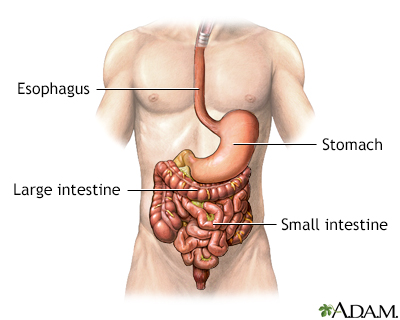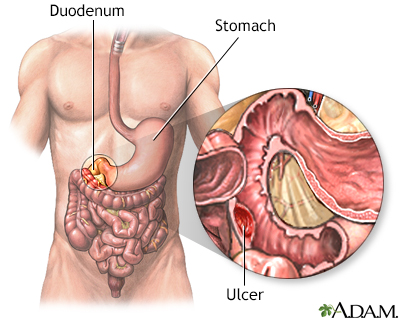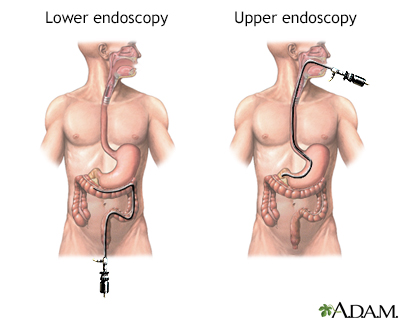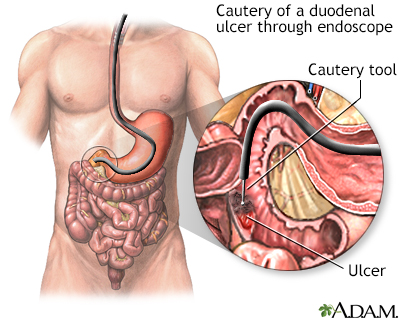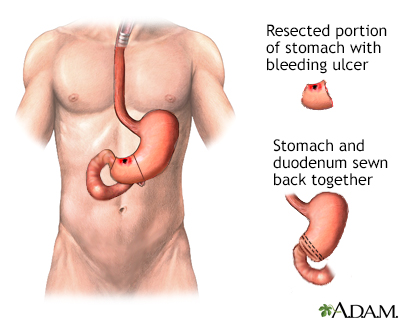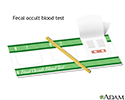Gastrointestinal bleeding
Lower GI bleeding; GI bleeding; Upper GI bleeding; HematocheziaGastrointestinal (GI) bleeding refers to any bleeding that starts in the gastrointestinal tract.
Bleeding may come from any site along the GI tract, but is often divided into:
- Upper GI bleeding: The upper GI tract includes the esophagus (the tube from the mouth to the stomach), stomach, and first part of the small intestine (duodenum).
- Lower GI bleeding: The lower GI tract includes most of the small intestine, large intestine, rectum, and anus.
Considerations
The amount of GI bleeding may be so small that it can only be detected on a lab test, such as the fecal occult blood test. Other signs of GI bleeding include:
- Dark, tarry stools
- Larger amounts of blood passed from the rectum
- Small amounts of blood in the toilet bowl, on toilet paper, or in streaks on stool (feces)
- Vomiting blood
Massive bleeding from the GI tract can be dangerous. However, even very small amounts of bleeding that occur over a long period of time can lead to problems such as anemia or low blood counts.
Anemia
Anemia is a condition in which the body does not have enough healthy red blood cells. Red blood cells provide oxygen to body tissues. Different type...

Once a bleeding site is found, many therapies are available to stop the bleeding or treat the cause.
Causes
GI bleeding may be due to conditions that are not serious, including:
-
Anal fissure
Anal fissure
An anal fissure is a small split or tear in the thin moist tissue (mucosa) lining the lower rectum (anus).
 ImageRead Article Now Book Mark Article
ImageRead Article Now Book Mark Article -
Hemorrhoids
Hemorrhoids
Hemorrhoids are swollen veins in the anus or lower part of the rectum.
 ImageRead Article Now Book Mark Article
ImageRead Article Now Book Mark Article
GI bleeding may also be a sign of more serious diseases and conditions. These may include cancers of the GI tract, such as:
- Cancer of the colon
- Cancer of the small intestine
- Cancer of the stomach
- Intestinal polyps (a pre-cancerous condition)
Other causes of GI bleeding may include:
- Abnormal blood vessels in the lining of the intestines (also called angiodysplasia)
- Bleeding diverticulum, or diverticulosis
Diverticulosis
Diverticulosis occurs when small, bulging sacs or pouches form on the inner wall of the intestine. These sacs are called diverticula. Most often, t...
 ImageRead Article Now Book Mark Article
ImageRead Article Now Book Mark Article - Crohn disease or ulcerative colitis
Ulcerative colitis
Ulcerative colitis is a condition in which the lining of the large intestine (colon) and rectum become inflamed. It is a form of inflammatory bowel ...
 ImageRead Article Now Book Mark Article
ImageRead Article Now Book Mark Article - Esophageal varices
-
Esophagitis
Esophagitis
Esophagitis is a condition in which the lining of the esophagus becomes swollen, inflamed, or irritated. The esophagus is the tube that leads from y...
 ImageRead Article Now Book Mark Article
ImageRead Article Now Book Mark Article - Gastric (stomach) ulcer
- Intussusception (bowel telescoped on itself)
-
Mallory-Weiss tear
Mallory-Weiss tear
A Mallory-Weiss tear occurs in the mucous membrane of the lower part of the esophagus or upper part of the stomach, near where they join. The tear m...
 ImageRead Article Now Book Mark Article
ImageRead Article Now Book Mark Article -
Meckel diverticulum
Meckel diverticulum
A Meckel diverticulum is a pouch on the wall of the lower part of the small intestine that is present at birth (congenital). The diverticulum may co...
 ImageRead Article Now Book Mark Article
ImageRead Article Now Book Mark Article - Radiation injury to the bowel
Home Care
There are home stool tests for microscopic blood that may be recommended for people with anemia or for colon cancer screening.
When to Contact a Medical Professional
Contact your health care provider if:
- You have black, tarry stools (this may be a sign of GI bleeding)
Black, tarry stools
Black or tarry stools with a foul smell are a sign of a problem in the upper digestive tract. It most often indicates that there is bleeding in the ...
 ImageRead Article Now Book Mark Article
ImageRead Article Now Book Mark Article - You have blood in your stool
- You vomit blood or you vomit material that looks like coffee grounds
Vomit blood
Vomiting blood is regurgitating (throwing up) contents of the stomach that contains blood. Vomited blood may appear bright red, dark red, or look lik...
Read Article Now Book Mark Article
What to Expect at Your Office Visit
Your provider may discover GI bleeding during an exam at your office visit.
GI bleeding can be an emergency condition that requires immediate medical care. Treatment may involve:
- Blood transfusions.
- Fluids and medicines through a vein.
- Esophagogastroduodenoscopy (EGD). A thin tube with a camera on the end is passed through your mouth into your esophagus, stomach, and small intestine.
- A tube that is placed through your mouth into the stomach to drain the stomach contents (gastric lavage).
Once your condition is stable, you will have a physical exam and a detailed exam of your abdomen. You will also be asked questions about your symptoms, including:
- When did you first notice symptoms?
- Did you have black, tarry stools or red blood in the stools?
- Have you vomited blood?
- Did you vomit material that looks like coffee grounds?
- Do you have a history of peptic or duodenal ulcers?
- Have you ever had symptoms like this before?
- What other symptoms do you have?
Tests that may be done include:
- Abdominal CT scan
- Abdominal MRI scan
- Abdominal x-ray
- Angiography
- Bleeding scan (tagged red blood cell scan)
- Blood clotting tests
- Capsule endoscopy (camera shaped like a pill that is swallowed to look at the small intestine)
Endoscopy
Endoscopy is a way of looking inside the body. Endoscopy is often done with a tube put into the body that the doctor can use to look inside. Anothe...
 ImageRead Article Now Book Mark Article
ImageRead Article Now Book Mark Article - Colonoscopy
- Complete blood count (CBC), clotting tests, platelet count, and other laboratory tests
- EGD
-
Enteroscopy
Enteroscopy
Enteroscopy is a procedure used to examine the small intestine (small bowel).
 ImageRead Article Now Book Mark Article
ImageRead Article Now Book Mark Article -
Sigmoidoscopy
Sigmoidoscopy
Sigmoidoscopy is a procedure used to see inside the sigmoid colon and rectum. The sigmoid colon is the area of the large intestine nearest to the re...
 ImageRead Article Now Book Mark Article
ImageRead Article Now Book Mark Article
References
DeGeorge LM, Nable JV. Gastrointestinal bleeding. In: Walls RM, ed. Rosen's Emergency Medicine: Concepts and Clinical Practice. 10th ed. Philadelphia, PA: Elsevier; 2023:chap 26.
Kovacs TO, Jensen DM. Gastrointestinal hemorrhage. In: Goldman L, Schafer AI, eds. Goldman-Cecil Medicine. 26th ed. Philadelphia, PA: Elsevier; 2020:chap 126.
Savides TJ, Jensen DM. Gastrointestinal bleeding. In: Feldman M, Friedman LS, Brandt LJ, eds. Sleisenger and Fordtran's Gastrointestinal and Liver Disease. 11th ed. Philadelphia, PA: Elsevier; 2021:chap 20.
-
GI bleeding - series - Normal anatomy
Presentation
-
Fecal occult blood test - illustration
A fecal occult blood test is a noninvasive test that detects the presence of hidden blood in the stool. Blood in the stool that is not visible is often the first, and in many cases the only, warning sign that a person has colorectal disease, including colon cancer.
Fecal occult blood test
illustration
-
GI bleeding - series - Normal anatomy
Presentation
-
Fecal occult blood test - illustration
A fecal occult blood test is a noninvasive test that detects the presence of hidden blood in the stool. Blood in the stool that is not visible is often the first, and in many cases the only, warning sign that a person has colorectal disease, including colon cancer.
Fecal occult blood test
illustration
Review Date: 1/30/2023
Reviewed By: Michael M. Phillips, MD, Emeritus Professor of Medicine, The George Washington University School of Medicine, Washington, DC. Also reviewed by David C. Dugdale, MD, Medical Director, Brenda Conaway, Editorial Director, and the A.D.A.M. Editorial team.



